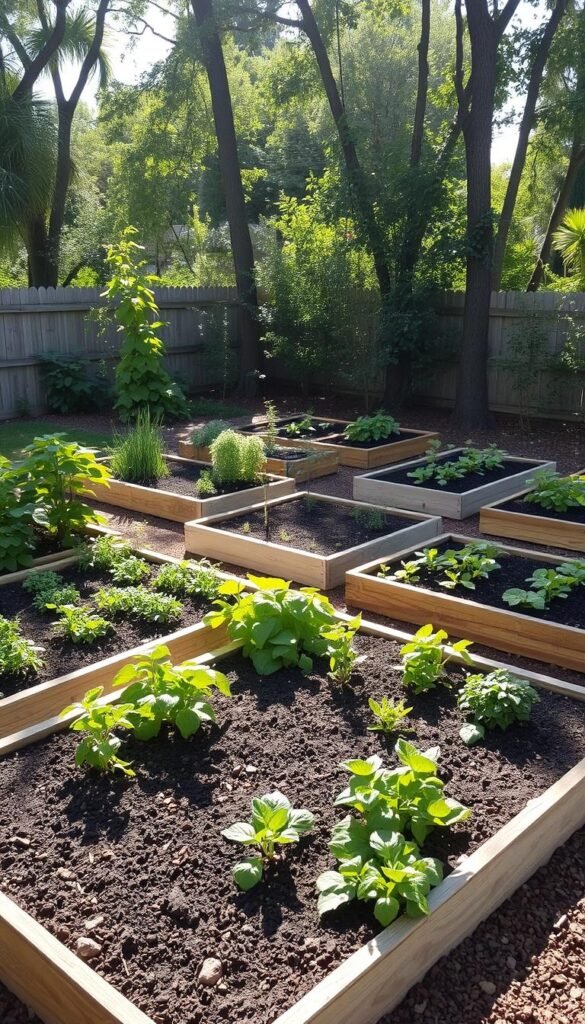Just because your outdoor area is compact doesn’t mean your harvest has to be. Creative growing solutions shine brightest when space is tight, and elevated planting systems lead the charge. These structures turn cramped corners, patios, or modest yards into organized, productive zones that outperform conventional ground-level plots.
You’ll find these versatile growing spaces solve multiple challenges at once. They improve soil control, reduce weeds, and create visual appeal where flat dirt might otherwise dominate. With smart layouts, you can grow more food in 50 square feet than many do in larger, unplanned areas.
This guide shows how to select shapes and materials that complement your available room while maximizing yield. Discover vertical stacking tricks, companion planting strategies, and space-saving layouts that make every inch count. You’ll learn why proper bed depth matters for root crops and how sun exposure influences your arrangement.
Turn limitations into advantages by embracing clever organization. Your cozy growing zone can become a lush, efficient food source that rivals sprawling plots – all through intentional planning and modern small-space techniques.
Why Raised Beds are Ideal for Small Backyards
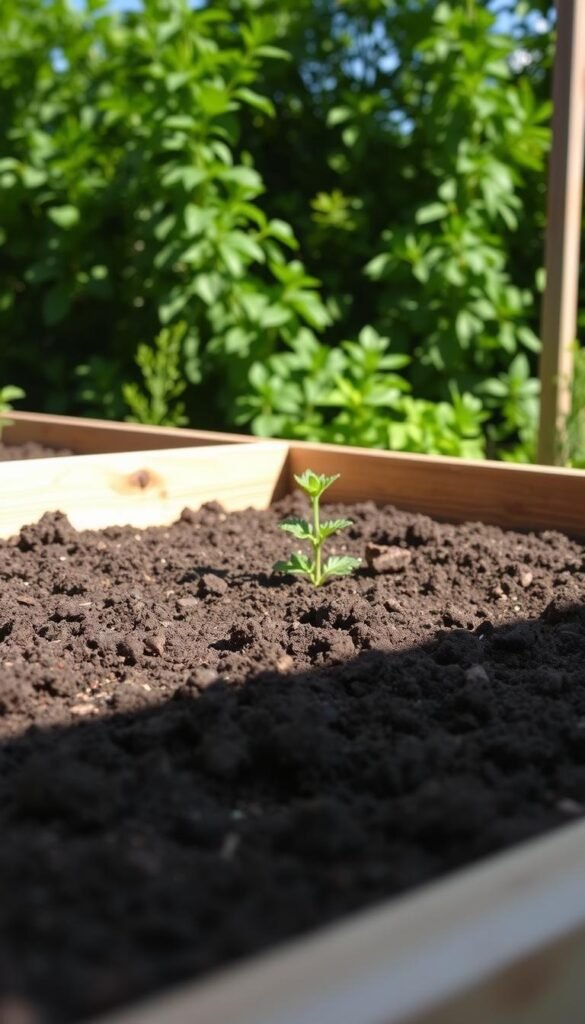
Transforming tight spaces into lush growing zones begins with smart solutions. Elevated planters solve common small-yard challenges while multiplying your growing potential. These structures aren’t just space-savers – they’re game-changers for cultivating healthy plants efficiently.
Enhanced Soil Control and Drainage
You gain complete command over your growing environment with contained soil systems. Unlike ground plots, you fill these planters with nutrient-rich mixes tailored to your crops. This means no more battling clay-heavy earth or rocky substrates lurking beneath your property.
Proper drainage becomes automatic thanks to elevated designs. Water flows freely through loose, aerated soil – crucial for preventing root rot in confined spaces. You’ll notice plants thrive without the soggy conditions that plague traditional gardens after heavy rains.
Improved Accessibility and Ergonomics
Say goodbye to back strain from constant bending. These elevated systems bring plants to waist level, making seeding and harvesting comfortable. For those with mobility challenges, this feature can transform gardening from difficult to delightful.
The ergonomic design also simplifies maintenance. You’ll spend less time weeding and more time enjoying your green space. Want to start your own? Our step-by-step raised bed construction guide makes setup straightforward.
Warmer soil in spring gives your plants a growth headstart. You’ll harvest veggies weeks earlier than neighbors using ground-level plots. This extended season means more fresh produce from the same square footage.
Backyard Raised Garden Beds Design: Boosting Your Yield in Limited Spaces
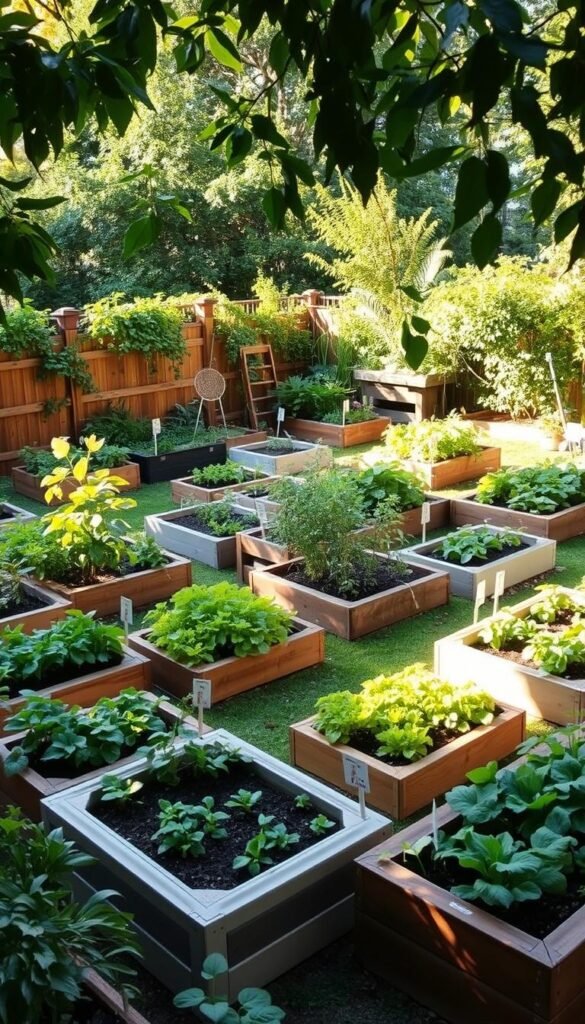
Small yards become productive powerhouses when you shape your growing areas to match the land. Unlike rigid traditional plots, these adaptable systems bend to your property’s contours. Curved planters follow winding pathways, while tiered setups create visual depth on slopes.
Your layout options stretch far beyond basic rectangles. Consider these creative approaches:
- Vertical stacks for vine crops like beans
- Narrow planters along fence lines
- Modular units that expand as needed
One gardener transformed their 10’x12′ patio using this principle: “We built L-shaped planters around existing trees – now herbs and flowers grow where weeds once thrived.”
Balance beauty and function by choosing materials that complement your home’s style. Rustic cedar beds pair well with cottage landscapes, while sleek metal troughs suit modern aesthetics. For those starting small, budget-friendly square foot layouts offer immediate results without overwhelming complexity.
Smart spacing makes all the difference. Allow 18-24″ between planters for comfortable access. Mix shallow-rooted greens with deep containers for carrots and potatoes. You’ll maximize production while maintaining clean sightlines.
Remember: Your setup should evolve with your skills. Start simple, then add trellises or decorative edging as confidence grows. Every thoughtful choice brings you closer to a personalized oasis that feeds both body and soul.
Creative Layouts for Maximum Garden Yield
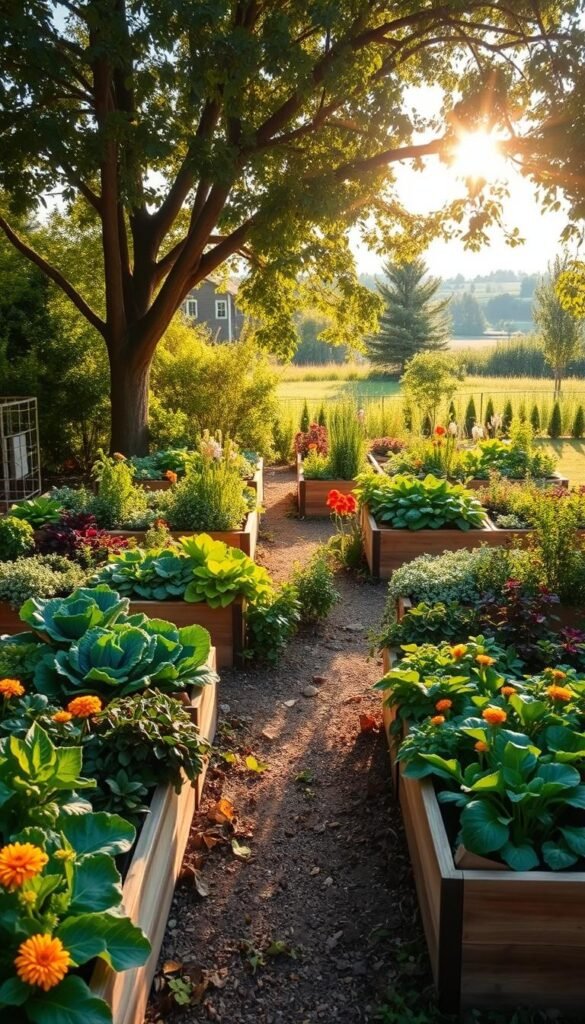
Unlock hidden potential in overlooked zones through smart spatial planning. Thoughtful arrangements turn forgotten edges and awkward corners into lush, food-producing hubs. Let’s explore two powerful approaches that squeeze productivity from every square foot.
Narrow and Long Beds for Edge Utilization
Transform perimeter zones into thriving growing areas with slim planters. A 1.5-foot-wide bed along fences accommodates carrots, radishes, or vertical cucumbers without crowding walkways. These linear space-savers work particularly well for herbs like rosemary that thrive in contained environments.
You’ll love how these slender garden bed ideas maintain open central spaces. Trellised peas or pole beans add height without sacrificing ground room. One urban grower reported: “Our 18-inch-wide border beds now produce 40% of our summer greens!”
L-Shaped and Corner Configurations
Capitalize on underused angles with planters that wrap around obstacles. These multi-directional raised bed designs create natural focal points while expanding planting real estate. Perfect for corner spots where two walls meet, they transform dead zones into productive vegetable nooks.
You’ll achieve both form and function with angular layouts. The L-shape defines distinct garden areas – perhaps a culinary herb quadrant near the grill or cut-flower station by seating areas. For best results, pair deep-rooted tomatoes in the corner’s deepest point with shallow lettuces along the arms.
Remember: Successful small-space design thrives on intentional placement. Whether hugging boundaries or claiming corners, your strategic layout choices multiply harvests while enhancing outdoor aesthetics.
Utilizing Vertical Space with Trellises and Modular Designs
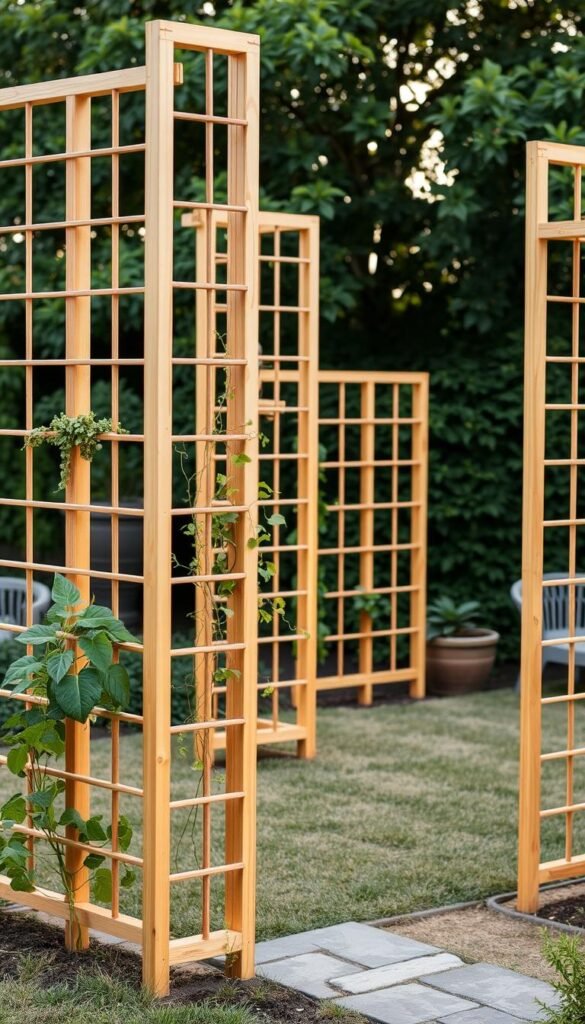
When ground space is scarce, look upward to unlock new growing dimensions. Vertical elements transform unused airspace into thriving plant zones while keeping pathways clear. This approach works wonders for vining crops that naturally reach for sunlight.
Vertical Add-Ons for Climbing Plants
Attach trellises or cages to your raised bed frames to support cucumbers and pole beans. These structures guide plants upward, improving air circulation and reducing pest issues. One gardener shared: “My peas yield twice as much since switching to vertical growth – plus harvesting at eye level is easier!”
Consider lightweight wall planters for strawberries or herbs. They create edible art while freeing soil space below for root vegetables. For heavy squashes, use sturdy A-frame supports anchored in bed corners.
Modular Designs to Scale Your Garden
Expand your growing area gradually with stackable units. These adaptable systems let you grow lettuce in upper tiers while deeper layers host carrots or potatoes. Rotate modules seasonally – move shade-loving greens beneath taller summer crops.
Interlocking beds serve multiple purposes. Use them as room dividers that burst with nasturtiums or morning glories. As your skills grow, add new sections to test different gardening techniques without overhauling your entire setup.
Want more small-space solutions? Explore our guide on maximizing compact growing areas for year-round harvests. Remember: Going vertical isn’t just practical – it turns functional structures into living decor that delights the senses.
Incorporating Multi-functional Features into Raised Beds
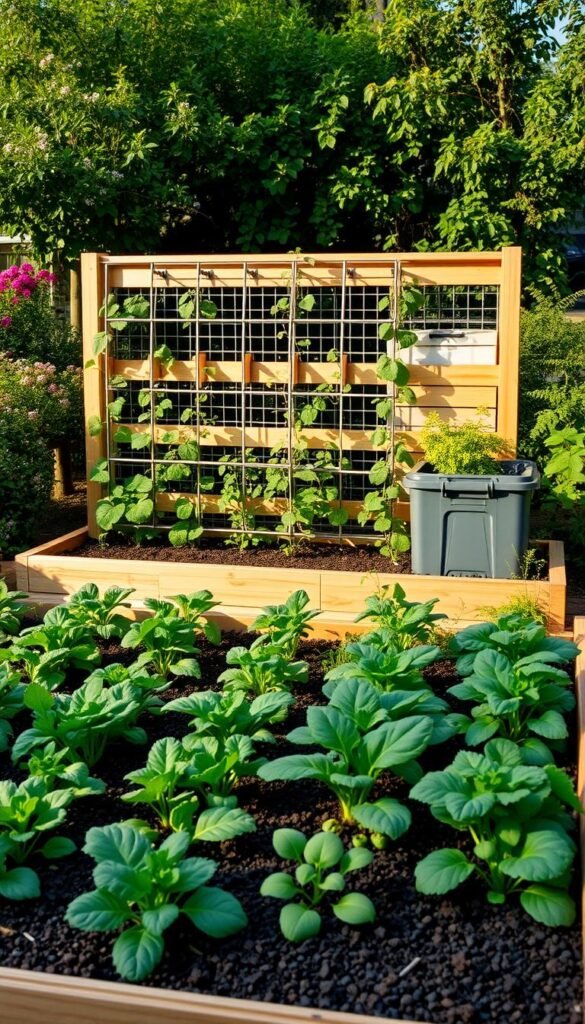
Smart growing spaces do more than nurture plants – they enhance your entire outdoor experience. By blending practical elements into your setup, you create areas that work double-duty without eating up precious square footage.
Seating That Serves Two Purposes
Attach benches directly to your raised bed frames for instant relaxation spots. These built-in perches become perfect places to sip morning coffee while checking plant progress. One urban grower noted: “Our corner bench stores potting mix underneath – we use every cubic inch!”
Consider these space-smart ideas:
- Lid-topped storage boxes that double as stepping stools
- Fold-down seats that tuck away when not needed
- Weatherproof drawers built into bed sides for tools
Hidden Storage Solutions
Your beds can discreetly hold all essential supplies. Hollow bench seats keep gloves and shears dry yet accessible. Vertical boxes mounted on bed ends organize seed packets and plant markers.
You’ll love how these features maintain a clean look while boosting functionality. No more tripping over watering cans or searching for trowels – everything stays within arm’s reach yet out of sight.
Integrating storage directly into your growing area means less clutter and more enjoyment. Your garden becomes an organized oasis where productivity meets relaxation seamlessly.
Materials Guide for Durable and Eco-Friendly Raised Beds
Building a lasting foundation starts with smart material choices. Your planters’ structure directly impacts safety, durability, and soil health. Let’s explore options that protect your garden ecosystem while standing strong against weather and time.
Selecting Quality Wood and Alternatives
Cedar and redwood lead the pack for natural resilience. These woods contain protective oils that fend off rot and insects without chemical treatments. Over time, they develop a handsome silvery patina that blends beautifully with outdoor spaces.
While pine or fir cost less upfront, they degrade faster. One gardener shared: “My cedar beds still look great after 12 seasons – worth every penny!” For budget-friendly projects, consider lining cheaper woods with landscape fabric to slow decay.
Comparing Treated vs. Untreated Materials
Safety first with edible crops. Modern pressure-treated lumber uses copper-based preservatives, but the USDA bans it in organic systems. Chemicals might seep into your soil, especially in acidic conditions common with vegetables.
| Material | Safety | Durability | Cost |
|---|---|---|---|
| Cedar | Food-safe | 10+ years | $$$ |
| Redwood | Food-safe | 10+ years | $$$$ |
| Pressure-Treated | Debated | 15+ years | $$ |
For long-term savings, natural rot-resistant woods outperform cheaper alternatives. Need building guidance? Our step-by-step construction guide simplifies the process using safe materials.
Compact Garden Strategies for Urban Yards
Urban living doesn’t have to limit your green thumb potential. With clever planning, even balcony corners or fire escape-adjacent areas can burst with fresh herbs and veggies. The secret lies in reimagining vertical surfaces and overlooked nooks as prime growing real estate.
Maximizing Every Square Inch
Vertical solutions shine in concrete jungles. Hang lightweight planters from railings or install wall-mounted pockets for strawberries and leafy greens. One apartment gardener shared: “My 3-foot-wide ledge now holds 18 plants using tiered shelves – all within arm’s reach!”
Combine form and function with dual-purpose features. A fold-down table becomes a potting station, while magnetic spice racks keep tools organized. For inspiration, explore creative vertical setups that turn blank walls into living art.
Prioritize plants that thrive in tight quarters. Dwarf tomato varieties and compact peppers deliver big flavors without sprawling. Herbs like thyme and oregano flourish in shallow containers, perfect for windowsills. Remember: Multiple small harvests often outproduce single large plantings in cramped areas.
Your urban oasis can reduce stress while feeding your kitchen. Start with one sunny spot, then expand as confidence grows. Even micro-gardens make mighty impacts when every inch works smarter.

